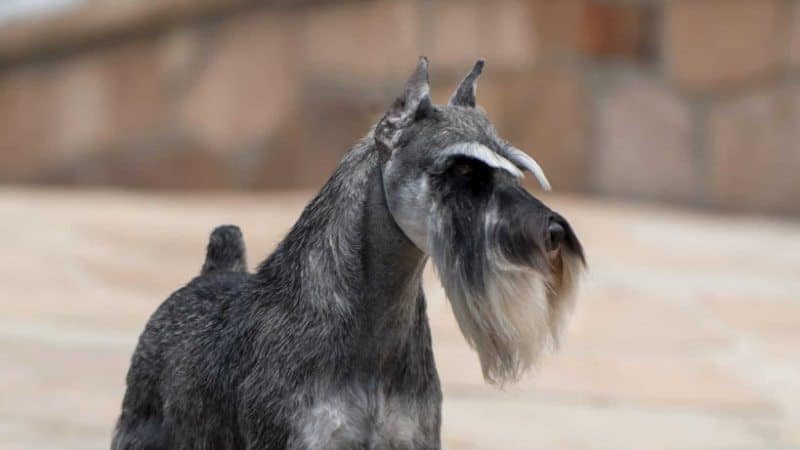Why We Breed Miniature Schnauzers
We asked the following questions to experts involved in the breeding & showing of Miniature Schnauzers. Here are their collective responses:
- Where do you live? What do you do “outside” of dogs?
- How many years in the Miniature Schnauzer? Showing? Judging? Breeding?
- What, in your opinion, is the secret to a successful breeding program?
- Its position as #19 out of all AKC breeds is an indication of the love the world has for the Miniature Schnauzer. Does this make finding good homes easier?
- Are grooming trends affecting the breed in the ring today?
- What is your favorite dog show memory?
- Is there anything else you’d like to share about the breed? Please elaborate.
Carma Ewer
Galen and I have been involved with Miniature Schnauzers for the past 43 years. During that time, we have been active members of the American Miniature Schnauzer Club. I have held the positions of President, Secretary, and have served on the board for a number of years. We have also been active in our local Kennel clubs, and have served as officers and show chairman numerous times. In the past 12 years, we have either bred or owned four number one dogs and currently have the top winning Miniature Schnauzer—our bitch, GCHG Carmel Sky High Wish Upon A Star, who is ranked number one in breed and all breed, plus is a Top Ten Terrier. Twink was owner handled in 2018 and is now enjoying life with Susie and Jorge Olivera, where she has broken the record for All Breed Bests In Shows for Miniature Schnauzer bitches with six to date.
My husband and I live in Sandy, Utah; a suburb of Salt Lake City. We enjoy snow skiing, hiking in our mountains, spending time with family—including our grandchildren and activities with our church family.
We have been involved with Miniature Schnauzers for 43 years. My husband gave me a Mini Schnauzer as a pet for Valentines Day the year we were married. That led to obedience training, then showing in obedience, and then on to conformation. While our children were young and home, we were busy with their activities and lives, but still managed an occasional dog show. Now that they have all married and have families of their own, we have been able to enjoy our dog show hobby full time.
The secret to a successful breeding program? That’s a tough question. I say that one big factor in a successful breeding program is to start with a really good foundation, and then not be afraid to seek out the best partner for breeding. Regardless of where they are located. Modern medicine has made it much easier to find that perfect stud dog to compliment your breeding program. Also, be hyper critical of your puppies. It’s hard but I am fortunate to have a spouse who is brutal when it comes to evaluating puppies. I tend to think they are all wonderful. But this has helped us only keep the best. I also think luck plays a part in success. We were fortunate enough to be blessed with some awesome mentors and dogs and have made incredible friendships and memories.
Finding Miniature Schnauzer homes is not a problem. It is a wonderful breed. The bigger problem is finding enough quality puppies for the homes that looking to add a Miniature Schnauzer to their households.
I don’t believe that grooming trends are affecting our breed today. But I will say that most of us who are exhibiting are getting very good at presentation and conditioning. I think that the Miniature Schnauzer today is presented much better than in the past.
My favorite dog show memory? Another tough question. I would say the most memorable memories are of those special moments when the judge pointed to us at a big show and we were so completely surprised. Not that we didn’t have a quality exhibit, but because there were so many quality exhibits in the ring with us.
I love this breed. They are wonderful companions, great with families and I can not imagine my life without one. When I am discouraged or heartbroken, there they are. Happy, loving and helping me know that no matter what happens—they are there for love and support. Miniature Schnauzers are hard-wired to think they are in charge of the world; I love that about them. And they are definitely in charge of our lives and household.
Marilyn Lande
I am originally from Minneapolis, Minnesota where I graduated from the University of Minnesota In Nursing. After graduation, I worked in surgery for 35 years as a scrub nurse, head nurse and Director of the Operating Rooms. During that time my interest in research found me in the laboratories after work. Most of the time was in gastric and cardiothoracic surgery. Working there with surgeons and biomedical engineers ultimately led to becoming a co-developer of the St. Jude heart valve and a contributor to the Medtronic pacemaker.
While still in school, I became an apprentice to the president of a brokerage firm which gave me great depth into the workings of the stock markets. My interests in investing, which came originally from my father, spread from the markets to rental buildings and raw land. During these years, sports were an outlet and I became a tennis and badminton champion. Since the age of seven, figure skating was my Saturday morning workout at the Minneapolis Ice Arena. Later, I skated in the St. Paul Pop Concerts . With all of these activities, there was still time for church every Sunday where I was the organist and choir director.
I have lived in Mesa, Arizona since 1991 and enjoy the area and nice weather very much.
Forty years ago I bought my first Miniature Schnauzer as a pet. However, that breeder asked if I would like to show my dog, Kerrie. What was showing? She became my mentor and showed me how to strip, rake coats, scissor etc. and my grooming techniques stemmed from that time. Later, we traveled almost every weekend to shows driving her little motorhome. We still share many hilarious events that occurred on our travels. I judged some fun matches and almost applied for my judging license but I couldn’t be gone from home that often. Showing my dogs became my ultimate passion which I did until moving to Arizona
The secret to a successful breeding program is having a thorough knowledge of the breed standard and breed for that standard. Not developing blindness to faults but researching ways to reduce or eliminate them. With all the technical help available today, research always pays off.
Does the breed’s ranking make finding good homes easier? I have more requests for puppies and adults than I have dogs to fill them.
Are grooming trends affecting the breed in the ring today? Handlers and Owners have developed such expertise in grooming that faults can easily be covered up. Given two dogs being equal, the best looking one will usually win.
My favorite dog show memory: I entered a brace in the Great Falls, Montana show. Landes Rhapsody in Blue (Gershwin) and Landes Just My Jack (Jack). Going in for Best Brace in Show I was shaking all over even after having practiced many times getting two dogs up on the table together. Then getting them down on the floor together without dropping the leads! We had six others of different breeds for competition. One especially beautiful pair of English Setters. After many trips around the ring and lining up, the judge walked back and forth several times. Walking toward me, she held out the big Best Brace in Show Ribbon.
I am still in love with this breed and continue having dogs in the show ring. Over the forty years I bred and showed my own dogs until 2006 when Multiple Sclerosis kept me out of the show ring. To this day, I still have dogs in the ring and attend shows using my cart.
Kate McMillan
Catherine (Kate) McMillan has been breeding Mini Schnauzers in Saskatchewan, Canada under the Minuteman prefix for over 35 years. Breeder of four AMSC National Specialty Best of Breed winners, including the number one ranked Miniature Schnauzers (breed and all-breed) in the US for both 2017 and 2018, along with the breeds number one producing sire for the past two years.
I live in a small town in Saskatchewan, Canada, about 200 miles north of Montana. I’m a commercial and fine artist by trade, which dovetails nicely into my dog sport.
I bought my foundation bitch (my first Mini) in 1981, knowing virtually nothing about the breed. I didn’t know what “stripping” was! Two years later I bred my first litter, from which my first Canadian Best in Show dog was born.
The secret to a successful breeding program is stamina. You must have the stamina to endure the learning curve, the setbacks, the financial challenges and, for me, the long drives to dog shows.
Does the breed’s ranking make finding good homes easier? There has typically been more demand for Mini Schnauzers than supply from reputable breeders, and thus the answer is yes. The nature of the breed attracts those who are looking for a family pet and keeps them coming back. Most of my callers are searching for their second or third Mini.
Are grooming trends affecting the breed in the ring today? Yes and no. It’s a highly challenging breed to trim to perfection—however, we’ve undergone a “changing of the guard” in recent years. Many of our leading exhibitors have semi-retired or passed away and a new generation is emerging. Not all yet trim to the level of a Bev Verna or Lanny Hirstein, so it’s a excellent time for newcomers to consider our breed as the competitive field is a more open than it has been for many years.
My favorite dog show memory is winning the breed at Montgomery County in 2012 with AmCanCh.Minuteman Goldikova, under Mr. Ken McDermott.
The most successful breeders in Mini Schnauzers have always been those who “do it themselves”. Follow their example: train your own puppies, groom your own dogs, show your own dogs. You can only develop the expertise required to excel in this breed by immersing yourself in its every aspect—history, genetics, structure and aesthetics. So put down the phone, get off Facebook and get to work!
Alberto Montila
I currently live in Seaside, California along the beautiful Monterey Bay. During the times I am not at shows I enjoy riding my Harley Davidson, going to the beach with our dogs/client dogs and spending time with friends and family.
I came to the United States about seven years ago to learn under my mentor Beverly Verna of Regency. I was involved in showing and breeding Miniature Schnauzers with Bev until her passing a few years ago. When Bev passed she left me a few of her dogs to continue on with showing and breeding from her line.
Afterwards I went to work for Bill and Taffe Mcfadden for a few years, which I am so thankful for not only learning so much from them but also for them becoming part of my life. While working Bill and Taffe I met Rachel Adams. Rachel and I went on our own as professional handlers under the Iberico name over a year ago. Together we are fulfilling our dreams of contributing as breeders and handlers of this sport.
When it comes to having a successful breeding program I think there are two things that are essential for success. The first being having a mentor. Having a mentor who can teach you, guide you and support you makes all of the difference in the world. If you are lucky enough your mentor will become more than just a teacher, they will become a lifelong friend or even part of your family. Though I no longer have my mentor Bev, I will always appreciate and cherish the time that we spent going to shows, whelping litters, and just enjoy Mini Schnauzers. The second tool which I think is essential for success is to be completely honest with yourself when it comes to the dogs in your program. It is so important when looking at your dogs with a critical eye that you not only see all of the great features of them but you equally are able to find their less desirable traits or faults. It is difficult to try and breed truly to the standard if you can not look at your dogs with an impartial eye.
Does the breed’s ranking make finding good homes easier? Absolutely! They are great family pets who can go out and do all the outdoor activities you like, but are also equally content sitting down with you to watch a movie. They are wonderful with children and are overall just a great dog. We have never had an issue trying to find good home for our puppies.
Are grooming trends affecting the breed in the ring today? I believe with every breed there are grooming trends that come and go in the show ring. Under truly good judges they will find the best quality representative of the breed regardless of what trends are circulating.
So far my most memorable and meaningful dog show memory was winning the American Miniature Schnauzer National Specialty back in April of this year. The dog who I won the breed with is MBISS GCHS Regencys Play to Win, his call name is Pepe. Winning the breed at the national was always a dream of mine, but to do it with Pepe made it so much more meaningful. Pepe was one of the last dogs that Bev bred when she was alive. A few years ago we took him to Montgomery County Kennel Club as a puppy and he won a huge Sweepstakes entry. He is a dog that Bev always had a lot of hopes and dreams for, by winning the national I feel that I have fulfilled what she always believed this dog was capable of.
Beth Santure
I purchased my first MS in 1983 and bred my first litter in 1985. I’ve bred over 30 champions most being entirely shown by myself. I have served on the National club (AMSC) board of directors multiple times and was President of local breed club several years running as well.
I am also a member of the local All Breed club and the local dog training club where I have been an instructor for many years.
I participate in obedience, rally, agility, barn Hunt and nose work with my dogs. I have bred and owned multiple dogs with titles at both ends of their names. I live in Michigan, near Ann Arbor. I’m retired from being a Veterinary Assistant for over 30 years. I’ve been breeding and showing in conformation and performance since 1985
The secret to a successful breeding program is to keep the puppy that has what you want to improve on.
Does the breed’s ranking make finding good homes easier? I’ve never had to advertise my puppies for sale and always have a wait list. Miniature Schnauzers are popular because they are a good fit for many families.
Are grooming trends affecting the breed in the ring today? I’d say there are grooming “styles”. Not everyone grooms exactly the same and a judge should be able to see and feel through the hair.
My favorite dog show memory is the first time going winners at a National Specialty.
Of course I’m bias, but I believe Miniature Schnauzers could be a breed for most people. They are considered a small breed but they are large in intelligence, personality and athleticism.
They are happy to go along with you to do whatever it is you want and come home to cuddle on your lap.
Dr. Lisa G. Sarvas
I was born in Western Canada, I have a BSA and DVM from the University of Saskatchewan. Small Animal Internship from Long Island Veterinary Specialists and the Josephine Deubler Fellowship in Medical Genetics and Reproduction from UPenn. I spent many years in Small Animal Reproduction, Emergency and Critical care and now work doing relief in Small Animal Medicine.
I live in Raleigh, North Carolina, I have a DVM and am active in my career, traveling, running and yoga. I’ve been showing for 34 years and breeding for 32 years.
The secret to a successful breeding program is it’s important to understand canine anatomy and how it makes up your breed’s type. Select dogs to start with a strong base of soundness (in reproductive traits, health and temperament) and then focus on breed type traits and selecting for virtues. Do not select for a generic, faultless dog- it will get you no where. Guard your heads, fronts and ribcages as they are the basis of our breed type. Keep your best bitches as they are gold.
Does the breed’s ranking make finding good homes easier? Overall, yes it does. Most pet homes are repeat Schnauzer buyers and they understand the high grooming requirements of a non shedding breed.
Are grooming trends affecting the breed in the ring today? I don’t think they have changed that much over the past five to ten years as we have always been a highly stylized breed with demanding stripping and scissoring needs. Most dog are shown in a roll which can be more difficult for novices to master. All breed handlers are prone to altering our outlines and proportions with excess hair which is far from where the breed started as a hard
coated ratter.
My favorite dog show memory is the thrill and excitement of attending my first Westminster Best in Show in 2003 after I moved to New York from Saskatoon, Saskatchewan.
We have an increasingly narrowing gene pool, with dominance of the Ruffian branch and virtual collapse of the Diplomate, Delegate and Tribute branches. As breeders we need to focus on keeping our tail male lines alive and maintaining some genetic diversity. We also have to be careful not to cull full families of dogs for producing health defects before that particular problem has been studied and a mode of inheritance is established.
We have a breed DQs for size that are not being monitored seriously by most judges. If judges question a dogs size, they need to measure. If breeders have questionable sized dogs, they need to police themselves to stay within our standard.








